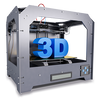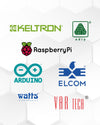
How to Select the Right Electronic Components for Your Project
Every great electronics project begins with an idea but making it come alive requires choosing the right components. Whether you're building a blinking LED badge or a smart irrigation controller, selecting suitable parts is the foundation for stability, efficiency, and success.
Choosing the wrong microcontroller, the wrong voltage regulator, or even the wrong resistor value can result in erratic behavior, power loss, or worst case a burnt board.
In this guide, we’ll walk you through how to choose the right components for your project, based on real-world needs, functionality, and compatibility.
1. Start With the Project’s Purpose
Before buying components, define what your project needs to do.
-
Is it a sensor-based system or an automation controller?
-
Does it need Wi-Fi or Bluetooth connectivity?
-
Will it be battery-powered or plugged in?
This helps you create a rough block diagram or list of functional units: input (sensors), processing (controller), output (display, relays), and power.
2. Choose the Right Power Source
Your circuit's power supply is its fundamental component. Choosing the right voltage and current capacity ensures everything runs smoothly.
Key Factors:
-
What voltage do your components need? (3.3V, 5V, 12V?)
-
Will you use batteries, USB, or wall adapters?
-
Do you need voltage regulation or conversion?
For portable projects, consider:
-
Boost converters to increase voltage
-
Buck converters to step it down
-
LDO regulators for low-noise applications
3. Select a Suitable Microcontroller
The microcontroller is your project's brain. It processes inputs and controls outputs based on logic you program.
Consider:
-
How many GPIO pins do you need?
-
Does it need ADC (analog to digital) or PWM?
-
Do you need connectivity (Wi-Fi, Bluetooth, USB)?
Popular choices:
-
Arduino Uno (Easy & Beginner Friendly)
-
ESP32 (Wi-Fi + Bluetooth + tons of I/O)
-
Raspberry Pi Pico (Tiny & Powerful)
4. Match Sensors to Inputs
The "eyes and ears" of your system are sensors. Selecting the right one depends on what you're measuring temperature, light, motion, gas, etc.
Consider:
-
Digital vs Analog output
-
Required resolution and accuracy
-
Supply voltage and interfacing logic
👉 Browse Sensors Collection
Examples:
-
DHT22 – Temperature & Humidity
-
PIR Motion Sensor – Detect Human Movement
-
Soil Moisture Sensor – Smart Gardening
5. Choose Output Devices
How will your project respond? Think about the actuators or output modules you’ll need.
Common Outputs:
Also consider:
6. Resistors, Capacitors & Passives
These components support core functionality like signal filtering, pull-up logic, voltage stability, etc.
Don’t underestimate the basics:
-
Use resistors to limit current and form voltage dividers.
-
Add capacitors near power pins for decoupling and timing.
-
Choose diodes for protection and rectification.
-
Use inductors for filtering power or building oscillators.
If you're unsure which values you’ll need, start with an assorted components kit.
7. Prototyping Tools
Before soldering, test everything on a breadboard. You’ll also need jumper wires and headers for connections.
If you plan to build a permanent version:
-
Get a soldering iron
-
Use perfboards or PCBs
-
Pick up connectors and enclosures
👉 Explore Tools & Testers
8. Physical Design Considerations
Your component selection will also depend on where and how the circuit will be used:
-
Does it need to be portable or compact?
-
Will it be exposed to moisture or vibration?
-
Do you need mounting holes or connectors?
For wearables, choose SMD components and compact boards like NodeMCU.
For outdoor use, consider waterproof enclosures and conformal coating.
9. Optimize for Availability and Budget
There’s no point designing around a part that’s hard to find or expensive. Always check:
-
Stock availability (from local suppliers like Tomson Electronics)
-
Pricing for singles vs. bulk
-
Lead time (especially for rare or imported parts)
Start with widely used and well-documented components. You'll find more community support, tutorials, and libraries.
10. Read Datasheets Seriously!
It may sound boring, but datasheets are your best friends. They contain:
-
Pin configurations
-
Electrical ratings (voltage, current)
-
Timing diagrams and usage notes
-
Absolute max limits (never cross these!)
Cross-reference datasheets before connecting power it's the best way to avoid mistakes.
Pro Tips for Smarter Selection
-
Plan before buying: Sketch your wiring diagram or flowchart.
-
Use simulation tools: Test basic circuits in tools like Tinkercad or Proteus.
-
Buy in small batches: Avoid bulk-buying unknown components.
-
Check tutorials: If it’s your first time using a module, look up how others used it.
-
Test often: Build and test each stage before combining them.
Final Thoughts: Start Small, Grow Smart
The key to selecting the right electronic components is understanding your project’s needs, doing some research, and learning through iteration. Start with the basics, keep experimenting, and as your circuits grow, so will your confidence.
And remember your components are only as good as your sourcing. At Tomson Electronics, we stock a wide range of tested, beginner-friendly, and affordable parts so you can focus on building.
👉 Start Browsing Electronic Components Now



